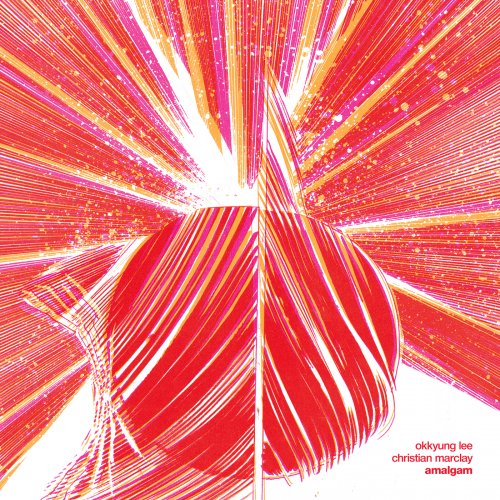Okkyung Lee & Christian Marclay - Amalgam (2016)

Artist: Okkyung Lee & Christian Marclay
Title: Amalgam
Year Of Release: 2016
Label: Northern Spy Records
Genre: Experimental, Cello, Folk
Quality: FLAC (tracks)
Total Time: 36:20 min
Total Size: 222 MB
WebSite: Album Preview
Tracklist:Title: Amalgam
Year Of Release: 2016
Label: Northern Spy Records
Genre: Experimental, Cello, Folk
Quality: FLAC (tracks)
Total Time: 36:20 min
Total Size: 222 MB
WebSite: Album Preview
1. Amalgam 36:20
Christian Marclay was one of turntablism’s earliest pioneers. Throughout the 1980s, the multimedia artist plundered the discographies of others: scratching and refracting one Hendrix jam into a fresh psychedelic swirl, or layering several pieces by Chopin or Louis Armstrong into new soundscapes. Less indebted to hip-hop sonics than to the genre-blending aesthetics of John Zorn, Marclay eventually began to collaborate with a range of players that included Thurston Moore and Ikue Mori.
Since his 24-hour installation film The Clock became a smash hit in contemporary art circles, Marclay has noticeably scaled back his turntablist practice. In recent years, he’s collaborated more with musicians through the interface of his collage-style “graphic scores.” But he still occasionally busts out his cartons of vinyl, as he did with the cellist Okkyung Lee for a 2014 performance at London’s Cafe Oto. Now released under the title Amalgam, the concert is easily one of Marclay’s most invigorating performances as a turntablist this century—and leagues more interesting than a pair of gigs released on limited-edition vinyl in conjunction with a 2015 gallery show in London.
A good deal of Amalgam’s success has to do with Marclay’s duet partner, Okkyung Lee. The cellist has demonstrated her avant-improv bona fides on her collaboration with piano great Cecil Taylor. And her own compositions display Lee’s skills with lyricism and melody, in between passages of crunch and noise. Appropriately, she has as many ideas for coaxing sounds from the cello as Marclay has strategies for abusing vinyl. This mutual acuity gives solid shape to their 36-minute, fully improvised performance.
After Marclay opens with samples that employ shifts in playback speed, Lee’s cello can be heard quietly, insistently repeating a short jagged phrase—a cellist’s imitation of a turntable scratch. Lee’s development of this brief figure gradually incorporates longer-held tones and broader fingerboard swoops, both of which help a listener identify her cello as the source of these particular sounds. By then, Marclay has begun splicing together noisier shards.
Not long after these discrete positions have been staked out by the two players, they pivot to blend their approaches. Occasionally, a figure that could have been produced by the live string player is revealed to be a Marclay sample, plucked from some string-laden LP. Metallic scrapings or atmospheric trails of sound production can seem like fodder from a vintage recording—until an expressive, violent burst in the line shows that this has all come from Lee’s cello.
This back and forth journey, between easy recognition of the different players and more ambiguous duo textures, creates much of the performance’s excitement at a minute-by-minute level. The larger structure follows a loose, three-movement style, with a quieter middle section that takes over in the fourteenth minute. Unlike many of Marclay’s past duo recordings with other artists, this session with Lee doesn’t include many recognizable samples. (You don’t even get any Anthony Braxton breaks that have cropped up in the turntablist’s collaborations with Elliott Sharp or Günter Müller.) But after this inspired performance, what lingers is the dazzling newness that Lee and Marclay create by exploring the outer fringes of timbre.
Since his 24-hour installation film The Clock became a smash hit in contemporary art circles, Marclay has noticeably scaled back his turntablist practice. In recent years, he’s collaborated more with musicians through the interface of his collage-style “graphic scores.” But he still occasionally busts out his cartons of vinyl, as he did with the cellist Okkyung Lee for a 2014 performance at London’s Cafe Oto. Now released under the title Amalgam, the concert is easily one of Marclay’s most invigorating performances as a turntablist this century—and leagues more interesting than a pair of gigs released on limited-edition vinyl in conjunction with a 2015 gallery show in London.
A good deal of Amalgam’s success has to do with Marclay’s duet partner, Okkyung Lee. The cellist has demonstrated her avant-improv bona fides on her collaboration with piano great Cecil Taylor. And her own compositions display Lee’s skills with lyricism and melody, in between passages of crunch and noise. Appropriately, she has as many ideas for coaxing sounds from the cello as Marclay has strategies for abusing vinyl. This mutual acuity gives solid shape to their 36-minute, fully improvised performance.
After Marclay opens with samples that employ shifts in playback speed, Lee’s cello can be heard quietly, insistently repeating a short jagged phrase—a cellist’s imitation of a turntable scratch. Lee’s development of this brief figure gradually incorporates longer-held tones and broader fingerboard swoops, both of which help a listener identify her cello as the source of these particular sounds. By then, Marclay has begun splicing together noisier shards.
Not long after these discrete positions have been staked out by the two players, they pivot to blend their approaches. Occasionally, a figure that could have been produced by the live string player is revealed to be a Marclay sample, plucked from some string-laden LP. Metallic scrapings or atmospheric trails of sound production can seem like fodder from a vintage recording—until an expressive, violent burst in the line shows that this has all come from Lee’s cello.
This back and forth journey, between easy recognition of the different players and more ambiguous duo textures, creates much of the performance’s excitement at a minute-by-minute level. The larger structure follows a loose, three-movement style, with a quieter middle section that takes over in the fourteenth minute. Unlike many of Marclay’s past duo recordings with other artists, this session with Lee doesn’t include many recognizable samples. (You don’t even get any Anthony Braxton breaks that have cropped up in the turntablist’s collaborations with Elliott Sharp or Günter Müller.) But after this inspired performance, what lingers is the dazzling newness that Lee and Marclay create by exploring the outer fringes of timbre.



![Cornelius Claudio Kreusch - Scoop (2025) [Hi-Res] Cornelius Claudio Kreusch - Scoop (2025) [Hi-Res]](https://www.dibpic.com/uploads/posts/2025-12/1765893706_folder.jpg)



![RAS - Rød i Blå (2025) [Hi-Res] RAS - Rød i Blå (2025) [Hi-Res]](https://www.dibpic.com/uploads/posts/2025-12/1765847447_s09xuo23tcu1a_600.jpg)
